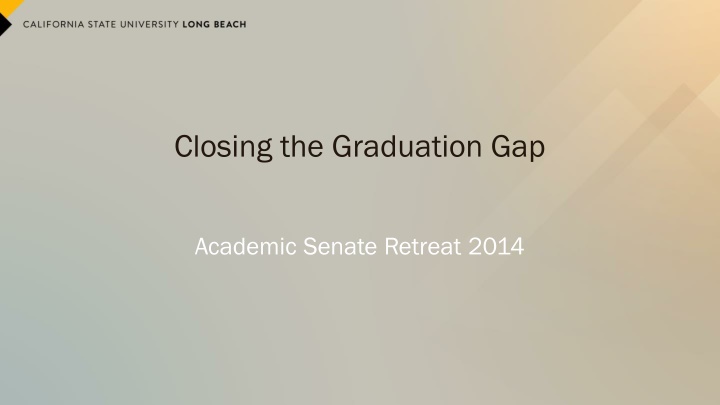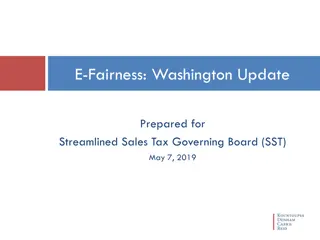Enhancing Graduation Success: Academic Senate Retreat Insights
The Academic Senate Retreat in 2014 focused on closing the graduation gap, emphasizing the importance of improving graduation rates and supporting student success. The event included discussions on serving students effectively, recognizing executive committee members, and addressing national graduation statistics. Presentations highlighted the benefits of graduation, setting the context for productive institutional actions towards improving outcomes for all students.
Download Presentation

Please find below an Image/Link to download the presentation.
The content on the website is provided AS IS for your information and personal use only. It may not be sold, licensed, or shared on other websites without obtaining consent from the author.If you encounter any issues during the download, it is possible that the publisher has removed the file from their server.
You are allowed to download the files provided on this website for personal or commercial use, subject to the condition that they are used lawfully. All files are the property of their respective owners.
The content on the website is provided AS IS for your information and personal use only. It may not be sold, licensed, or shared on other websites without obtaining consent from the author.
E N D
Presentation Transcript
Closing the Graduation Gap Academic Senate Retreat 2014
Agenda I. II. President Conoley III. Setting the Context IV. Table Time V. Reception Welcome
Closing the Graduation Gap Academic Senate Retreat 2014
Recognition Executive Committee Anna Ortiz Manuel P rez Maggie P rez-Mu oz Brett Waterfield Teri Yamada Guests: Brandon Gamble Jeff Klaus Angela Locks Lynn Mahoney Jos Moreno
Setting the Context I. The Graduation Gap National Picture CSULB II. What We Do Matters As an Institution In the Classroom Outside of the Classroom III. Table Time
Our Task Theme: Closing the Graduation Gap Two Trends Graduation rates The Graduation Gap Our Task How do we best serve all of our students to provide them the opportunity to succeed?
Graduation Matters Lifetime Earnings Other financial benefits Citizenship/Voting Volunteer Better Physical and Mental Health Sense of self Impact on the Community
Percent of U.S. Adults with a Bachelors Degree (2012) 33% EdTrust, 2014.
Percent of U.S. Adults with a Bachelors Degree 2012 EdTrust, 2014.
Graduation Rates: National Fewer than 4 in 10 (38%) entering full-time freshmen obtain a Bachelor s degree from the same institution within 4 years. Within six years of entry, that proportion rises to just under 6 in 10 (59%). National 6-Year graduation rates from ANY institution are at approximately 67%. Source: NCES (December 2013). Enrollment in Postsecondary Institutions, Fall 2012; Financial Statistics, Fiscal Year 2012; and Graduation Rates, Selected Cohorts, 2004-2009, First Look (Provisional Data) Table 4, via EdTrust.
National 6 Year Grad Rates: 2006 Cohort 80 70 Overall rate: 59% Graduation Rates (%) 60 50 40 71% 63% 30 52% 20 40% 40% 10 0 White Black Latino Asian American Indian Source: NCES (December 2013). Enrollment in Postsecondary Institutions, Fall 2012; Financial Statistics, Fiscal Year 2012; and Graduation Rates, Selected Cohorts, 2004-2009, First Look (Provisional Data) Table 3, via EdTrust.
6 Year Grad Rates: CSULB vs. Other CSUs 80 75 70 CSULB SDSU SLO CSUF CSUN CSU 65 60 55 50 45 40 35 30 F00 F01 F02 F03 F04 F05 F06 F07 CSU Chancellor s Office Analytic Studies http://www.asd.calstate.edu/csrde/index.shtml#ftf
6 Year Grad Rates by Ethnicity 70 65 60 CAUC A/PI AGG LAT AFAM NATAM 55 50 45 40 35 30 25 20 F95 F96 F97 F98 F99 F00 F01 F02 F03 F04 F05 F06 F07 CSULB, Office of Institutional Research and Assessment, Dashboard
Closing the Graduation Gap What does the phrase Graduation Gap mean? National and CSU data is categorized into two groups: Under Represented Minorities: African-American, Latino/a, Native American Non Under Represented Minorities: Caucasian, Asian/Pacific Islander
CA Graduation Gap in National Perspective 30% 25% 20% 15% 11.7% 10% 5% 0% -5% 2008-2010 Three-Year American Community Survey (ACS) data from NCHEMS Information Center, via EdTrust.
CSULB Graduation Gap 75 70 65 60 NURM CSULB AGG URM 55 50 45 40 35 30 F03 F04 F05 F06 F07 F08
Retention is Key The first two years are critical towards a student s success.
Why is there a Graduation Gap? The Usual Suspects College Readiness State Funding of Education
It is a fundamental assumption of this Retreat that what institutions do to help their students succeed matters. A lot. Let s focus on what we are doing well at CSULB, and what we can improve.
Mission/Access Beyond graduation rates Mission of access
Closing the Graduation Gap: National Best Practices Student success is a campus-wide priority. Data-based decision making is a norm. Advising is a top priority with clear, structured pathways to success. Course redesign is supported, especially for Introductory and Developmental Classes.
Closing the Graduation Gap: National Best Practices The most effective instructors are assigned to lower division courses. Professional development of faculty and staff is supported. The Campus recruits and retains diverse faculty and staff. Outreach is made to students who leave prior to graduation.
Closing the Graduation Gap: Best Practices In the Classroom Faculty establish a sense of community in the classroom. Faculty establish a sense of belonging in the class, major, discipline. Students receive consistent support and validation from instructors, even when students struggle.
Closing the Graduation Gap: Best Practices In the Classroom Faculty intentionally apply and connect coursework to their students lives. Assignments emphasize experiential and project- based learning. The administration and faculty support and mentor student research.
Closing the Graduation Gap: Best Practices Outside of the Classroom The campus strives to create a sense of community for all students. Under Represented students are given access to frequent, high-quality interactions with faculty outside of the classroom.
Closing the Graduation Gap: Best Practices Outside of the Classroom Student services and organizations provide activities and experiences designed to strengthen ethnic identities. The campus provides spaces and multi-cultural programming that encourage student interaction. The campus makes available jobs on campus for students who must work.
The Good News and The Work
Best Practices 1. In your experience as [student/faculty/staff/administrator], what are some major factors that contribute to student success (however defined): In the Classroom Outside of the Classroom
Best Practices 2. In your experience as [student/faculty/staff/administrator], what are some major factors that constitute obstacles/barriers to student success: In the Classroom Outside of the Classroom
Areas for Improvement 3. What can we do as an institution? 4. What can we do as individuals?
Thoughts? Ideas? Responses? Aracely.Montes@csulb.edu























